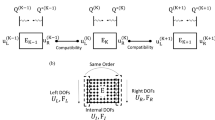Abstract
The objective of this work has been to study the propagation of elastic waves in rails. It presents the comparison of calculations obtained by the grid-characteristic and discontinuous Galerkin methods. The propagation of elastic waves in the presence and absence of the karst inclusion in the ground under the embankment, diagnosed in these cases from the rails, are compared. The wave pictures and diagnosed signals for four types of defects of a fractured character: vertical and horizontal head layering, cross fracture in the head and cracks in the rail web are given. The grid-characteristic method on the curvilinear structural meshes and the discontinuous Galerkin method on the nonstructured triangular meshes make it possible to solve efficiently the tasks on monitoring the state of the moving train and rail, including a great number of integrity violations, dynamic interactions in the train-rail system, and obtain the full wave picture.
Similar content being viewed by others
References
V. Novatskii, Theory of Elasticity (Mir, Moscow, 1975) [in Russian].
B. Petrov and A. S. Kholodov, “Numerical study of some dynamic problems of solid mechanics by the grid-characteristic method,” J. Exp. Theor. Phys. 24(5), 722–739 (1984).
I. Ye. Kvasov, I. B. Petrov, and F. B. Chelnokov, “Calculation of wave processes in non-homogenous spatial constructions,” Math. Models Comput. Simul. 21(5), 3–9 (2009).
I. Ye. Kvasov, S. A. Pankratov, and I. B. Petrov, “Numerical simulation of seismic responses in multilayer geological media by the grid-characteristic method,” Math. Models Comput. Simul. 3(2), 196–205 (2011).
I. B. Petrov, A. V. Favorskaya, I. Ye. Kvasov, and A. V. Sannikov, “Grid-characteristic method using high order with interpolation on tetrahedral hierarchical meshes with a multiple time step,” Math. Models Comput. Simul. 5(5), 409–416 (2013).
M. V. Muratov and I. B. Petrov, “Estimation of wave responses from subvertical macrofracture systems using a grid-characteristic method,” Math. Models Comput. Simul. 5(5), 479–492 (2013).
M. Kaser and M. Dumbster, “An arbitrary high discontinuous Galerkin Method for elastic waves on unstructured meshes in the two-dimensional case,” 166, 855–877 (2000).
M. Ye. Ladonkina, O. A. Neklyudova, and V. F. Tishkin, Preprint No. 34 (Keldysh Institute of Applied Mathematics, Russian Academy of Sciences, 2012).
M. Ye. Ladonkina, O. A. Nekhlyudova, and V. F. Tishkin, “Impact of different limiting functions on the order of solution obtained by RKDG,” Math. Models Comput. Simul. 5(4), 346–350 (2013).
M. Ye. Ladonkina, O. A. Nekhlyudova, and V. F. Tishkin, “Application of the RKDG method for gas dynamics problems,” Math. Models Comput. Simul. 6(4), 397–408 (2014).
Ami. Harten, “High resolution schemes for hyperbolic conservation laws,” Journal of Computational Physics 135(2), 260–278 (1997).
I. B. Petrov and N. I. Khokhlov, “Comparison of TVD limiters for numerical solution of the equations of the dynamics of a deformed solid by the grid-characteristic method,” in Mathematical Models and Problems of Control (2011), pp. 104–111 [in Russian].
P. L. Roe, “Characteristic-based schemes for the Euler equations,” Annual Review of Fluid Mechanics, No. 18, 337–365 (1986).
A. S. Kholodov and Ya. A. Kholodov, “Criteria of monotony of difference scheme for equations of the hyperbolic type,” J. Exp. Theor. Phys. 46(9), 1560–1588 (2006).
MPI Forum. Message Passing Interface (MPI) Forum Home Page. http://www.mpi-forum.org/ (2009).
V. I. Gritsyk, Defects of Rails in the Railway Track (Marshrut, Moscow, 2005) [in Russian].
Author information
Authors and Affiliations
Corresponding author
Additional information
Original Russian Text © I.B. Petrov, A.V. Favorskaya, N.I. Khokhlov, V.A. Miryakha, A.V. Sannikov, V.I. Golubev, 2014, published in Matematicheskoe Modelirovanie, 2014, Vol. 26, No. 7, pp. 19–32.
Rights and permissions
About this article
Cite this article
Petrov, I.B., Favorskaya, A.V., Khokhlov, N.I. et al. Monitoring the state of the moving train by use of high performance systems and modern computation methods. Math Models Comput Simul 7, 51–61 (2015). https://doi.org/10.1134/S2070048215010081
Received:
Published:
Issue Date:
DOI: https://doi.org/10.1134/S2070048215010081




